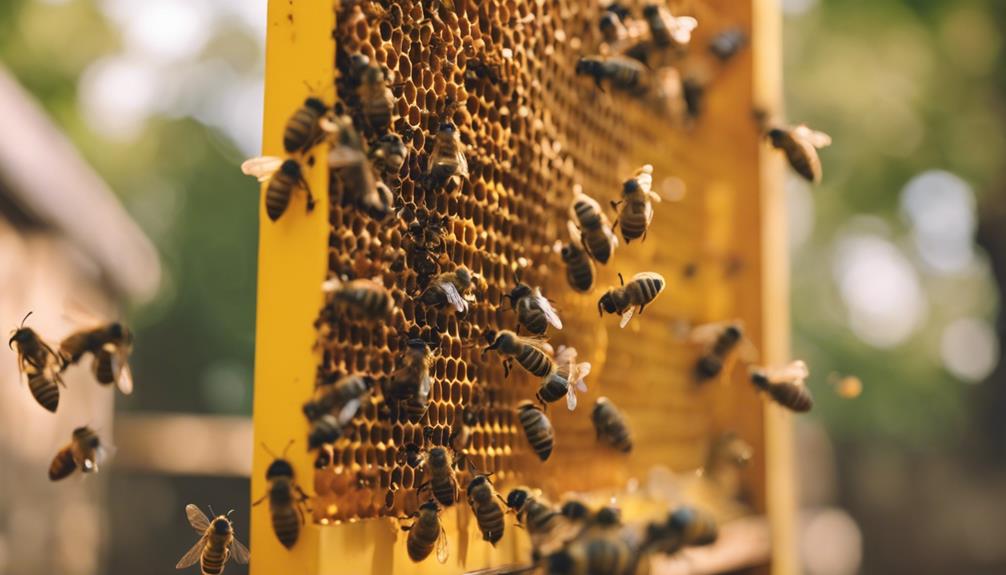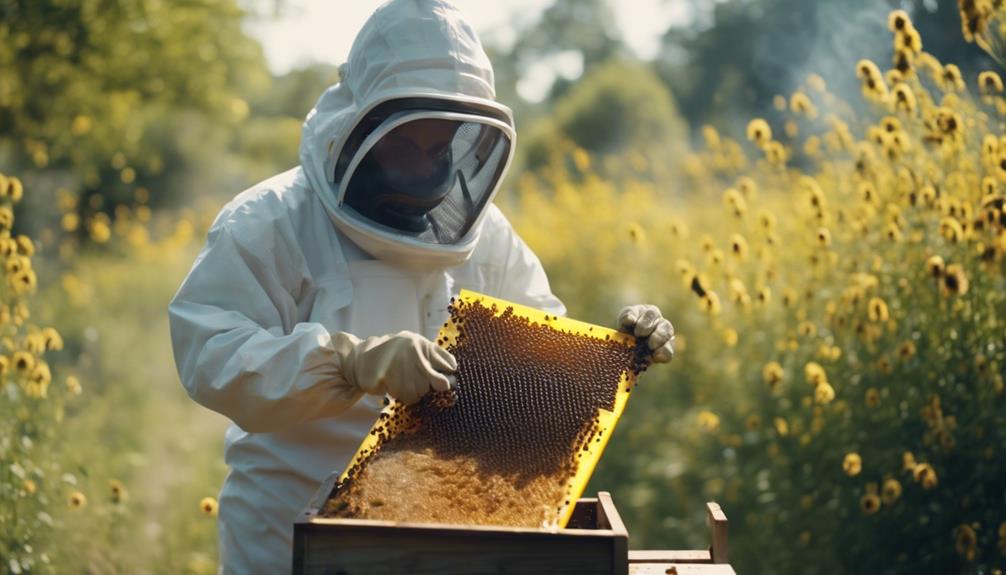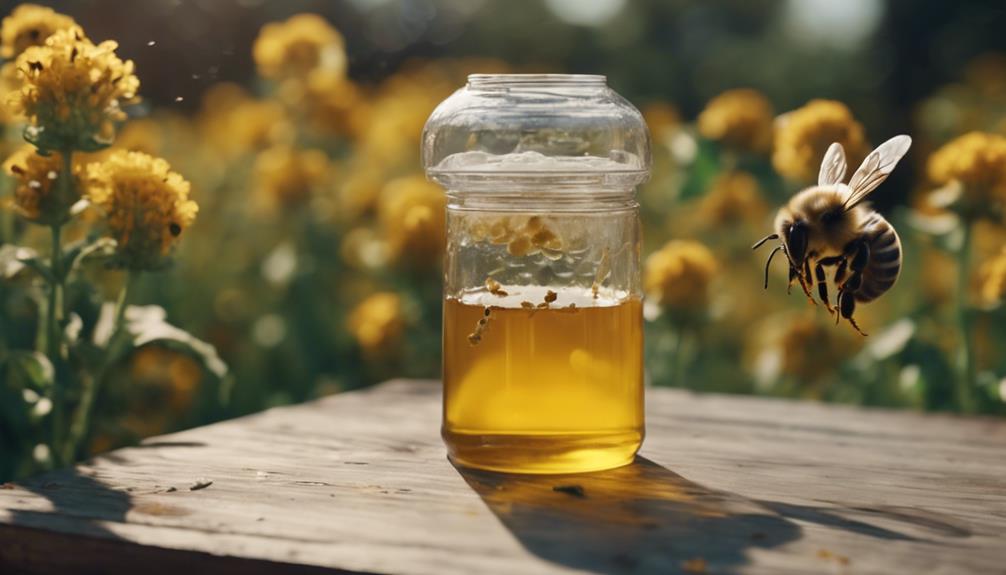When it comes to harvesting honey, we can definitely accomplish it without harming our buzzing buddies. By utilizing gentle extraction techniques, like bee escapes and traps, we guarantee the bees’ safety while grabbing that sweet nectar. Techniques such as smoke and escape cones help bees navigate the honey extraction process without causing them harm. These methods not only safeguard bee welfare but also contribute to sustainable beekeeping practices and the well-being of our planet. Wanna find out more about how to keep our bees happy and our honey jars full?
Main Points
- Utilize gentle extraction techniques to avoid harm.
- Employ non-invasive hive practices for bee safety.
- Use bee-friendly harvesting methods like escape cones.
- Prioritize bee welfare during the honey harvesting process.
- Sustainable beekeeping ensures honey extraction without killing bees.
Importance of Sustainable Beekeeping
Sustainable beekeeping plays an essential role in ensuring the well-being of bee populations and the longevity of honey production. When we prioritize sustainable practices, we aren’t just looking out for the bees; we’re safeguarding the future of our honey supply.
By maintaining healthy bee colonies, we’re supporting these incredible pollinators in their crucial role within ecosystems. A thriving bee colony means more than just honey – it signifies a balanced and flourishing environment.
Sustainable beekeeping isn’t just a trend; it’s a necessity for the well-being of our planet. When we commit to sustainable practices, we’re ensuring that bee populations can continue to thrive for generations to come.
Gentle Extraction Techniques for Bees
In regards to gently extracting honey from bee hives, beekeepers like us utilize tools and methods that respect the bees’ space and well-being.
By employing non-invasive practices and sustainable techniques, we can guarantee that the bees remain unharmed during the harvesting process.
Our priority is to prioritize bee safety, allowing us to collect honey without causing harm to these essential pollinators.
Bee-Friendly Harvesting Methods
Implementing bee-friendly harvesting methods involves utilizing gentle extraction techniques that prioritize the well-being of bees during the honey harvest. By using tools like blowers or escape cones, beekeepers can guarantee bees without causing them harm or unnecessary stress. This approach ensures that the bee colony remains healthy and thriving post-extraction.
Additionally, practices like returning any spilled honey back to the hive further support the overall well-being of the bees. These methods not only show respect for the bees’ hard work but also contribute to sustainable beekeeping practices. By considering the needs of the bees throughout the harvesting process, we can harvest honey while safeguarding the bee population and promoting their welfare.
Non-Invasive Hive Practices
Employing mild extraction techniques in beekeeping guarantees the well-being and safety of bees during the honey harvest. Non-invasive practices prioritize the health of the bee colony, ensuring minimal stress and harm during honey collection.
By utilizing methods like escape boards and bee escapes, beekeepers can extract honey without causing harm to the bees. These gentle removal techniques support the vitality of the hive, allowing bees to continue their essential tasks undisturbed.
Bee-friendly approaches not only benefit the bees but also contribute to sustainable beekeeping practices. It’s heartening to see how simple adjustments in harvesting methods can make a significant difference in preserving the well-being of these crucial pollinators.
Let’s continue to investigate and adopt non-invasive practices to promote a harmonious relationship with bees.
Sustainable Beekeeping Techniques
Employing gentle extraction techniques in sustainable beekeeping guarantees the well-being of bees during the honey harvesting process. By using bee escape boards and trap boards, we can harvest honey without causing harm to the colony. Techniques like employing an excluder and bottom Nadir help separate bees from honey frames, ensuring a smooth extraction process.
Tools such as blowers or shop vacuums on the exhaust side effectively remove bees from honeycomb, without injuring them. Enclosed frames in beehives provide stability during extraction, keeping bees safe and secure. Sustainable beekeeping practices prioritize the welfare of the colony, allowing us to harvest honey without sacrificing the bees.
It’s all about working in harmony with nature to guarantee both bees and beekeepers thrive.
Role of Smoking in Beekeeping
Using smoke in beekeeping plays an important role in calming bees and preparing them for hive inspections by disrupting their communication signals. When we introduce smoke, it triggers a natural response in bees to focus on consuming honey, as if they need to prepare for a potential relocation of their hive. This distraction makes the bees less aggressive and more focused on safeguarding their food source.
Throughout history, beekeepers have utilized various materials like burlap in smokers to generate the necessary smoke. It’s vital to apply smoke properly during hive inspections to minimize stress and prevent harm to the bees. By understanding the significance of smoking in beekeeping, we can guarantee a safer and more harmonious interaction with these incredible insects.
Bee Escapes for Ethical Honey Harvesting

Bee escapes are like little courteous doormen for bees, giving them a one-way ticket out of the honey super without a return pass. These clever devices work wonders in helping us separate the bees from the honey frames, all without causing any harm to our buzzing buddies.
Bee Escape Benefits
When implementing bee escapes in honey harvesting, beekeepers can guarantee a more humane and stress-free extraction process for the bees. Bee escapes offer multiple benefits that align with ethical beekeeping practices:
- Reduced Stress: By allowing bees to exit the honey supers without being able to return, bee escapes minimize the disruption to the hive, keeping the bees calmer during the harvesting process.
- Promote Bee Health: Bee escapes help maintain the overall well-being of the bee colony by avoiding unnecessary harm or distress, ensuring the bees can continue their crucial pollination work effectively.
- Ease of Harvesting: With bee escapes in place, beekeepers can efficiently collect honey from the hive without the need for invasive or harmful methods, making the extraction process smoother for both bees and beekeepers.
How Bee Escapes Work
Implementing ethical bee escapes in honey harvesting involves utilizing devices that allow bees to exit the honey super but prevent re-entry, ensuring a humane extraction process.
Bee escapes work by guiding bees out through a one-way mechanism, cleverly designed to let them return to the brood chamber while keeping harvested honey inaccessible.
These devices create a smooth exit route, like solving a puzzle for the bees, which minimizes stress and disruption to the colony.
By using bee escapes, beekeepers can harvest honey without causing harm to the bees, supporting sustainable beekeeping practices.
Prioritizing bee welfare, these mechanisms offer a gentle way to separate bees from the honey super during the extraction process, promoting a harmonious relationship between humans and these amazing pollinators.
Methods to Ensure Bee Safety
Guaranteeing the safety of bees during honey harvesting is a crucial aspect of maintaining healthy colonies. Here are three key methods to safeguard bee safety during the honey extraction process:
- Gentle Techniques: Employing gentle methods like bee escapes and trap boards can assist in harvesting honey without causing harm to the bees. These tools allow bees to exit the honey supers without getting trapped during the extraction process.
- Modern Hive Designs: Contemporary hive designs and bee management techniques have been developed to facilitate honey extraction while emphasizing bee survival. These designs provide a more conducive environment for bees during the harvesting process.
- Selective Colony Treatment: Eliminating infected colonies should only be done when necessary to prevent the spread of deadly diseases, not as a routine practice during honey harvesting. This selective approach helps in maintaining healthy bee populations.
Sustainable Practices in Honey Extraction

What sustainable practices can beekeepers employ to guarantee the ethical extraction of honey without harming bees?
Sustainable honey production relies on techniques that prioritize the well-being of our buzzing friends. By using bee escapes, traps, and modern hive designs, we can harvest honey without causing harm. Careful planning and tools like blowers help in safely removing bees from combs, ensuring a stress-free process for both the bees and us.
It’s essential for beekeepers to focus on bee welfare and colony health, as vital bees are essential for sustainable honey harvesting practices. By implementing these methods and keeping the bees’ best interests at heart, we can enjoy delicious honey while ensuring the bees thrive in their natural environment.
Bee-Friendly Honey Harvesting Approaches
To promote the well-being of bee colonies during honey extraction, beekeepers employ bee-friendly harvesting approaches that prioritize the safe separation of bees from honey frames. Here are three key techniques used in bee-friendly honey harvesting:
- Bee Escape Boards and Traps: These tools help in gently removing bees from honey frames without causing harm, allowing them to return to the hive unharmed.
- Gentle Bee Removal Tools: Implementing tools like blowers or brushes aids in the careful extraction of bees during the harvesting process, ensuring minimal disturbance to the colony.
- Survival and Health Priority: The ultimate goal of bee-friendly honey harvesting is to safeguard the survival and well-being of bee populations, emphasizing a harmonious approach to honey extraction that respects the bees’ natural habitat and behavior.
Ethical Considerations in Beekeeping

With a strong emphasis on ethical practices, beekeepers prioritize the well-being of bees in all aspects of honey harvesting. Harvesting honey without harming the bees is a top priority for us. We comprehend the importance of maintaining healthy colonies to guarantee sustainable honey production.
By following responsible beekeeping methods, we can extract honey without resorting to killing bees. It’s vital to respect the bees and their hard work throughout the harvesting process. Ethical considerations in beekeeping involve careful planning and gentle techniques to minimize stress on the bees.
Our goal is to protect the health and productivity of the colonies while enjoying the sweet rewards of their labor. Harvesting honey ethically isn’t just a practice but a way of showing gratitude towards these incredible pollinators.
Safeguarding Bee Welfare During Harvest
In the context of harvesting honey without harming bees, our attention shifts to safeguarding their welfare. Bee-friendly methods, such as utilizing bee escapes and traps, assist us in collecting honey while reducing stress on our buzzing friends.
Ensuring colony sustainability is fundamental to our practices, enabling us to foster a healthy environment for both bees and humans.
Bee-Friendly Harvesting Methods
Beekeepers prioritize safeguarding bee welfare during honey harvest by implementing bee-friendly techniques that aim to extract honey without harming the bees. Here are some bee-friendly harvesting methods that help guarantee the bees’ well-being:
- Escape Cones and Boards: These tools assist in removing bees from the honey frames without causing harm, allowing the bees to exit but not re-enter, ensuring a safe extraction process.
- Enclosed Frames: Using full frames enclosed within a hive box helps in separating bees from the honey frames effectively, reducing the chances of bee injury during extraction.
- Bottom Nadirs: By utilizing bottom nadirs, beekeepers create space for bees to move away from the honey frames, minimizing stress and potential harm to the bees during harvest.
These methods prioritize bee safety and health, allowing them to continue their essential roles within the hive after honey extraction.
Minimizing Bee Stress
How can bee welfare be safeguarded during the honey harvest process to minimize stress on the bees?
Bee escape boards are a valuable tool for ensuring a gentle harvest. By using bee escape boards, we can encourage bees to leave the supers without harming them. This method allows for a more peaceful extraction process, reducing stress on the bees.
Additionally, maintaining a calm demeanor and working methodically during the harvest can help minimize disruptions to the hive. Proper ventilation and lighting in the harvesting area are also essential in creating a comfortable environment for the bees.
Ensuring Colony Sustainability
To ensure the sustainability of our bee colonies during the honey harvest, we prioritize safeguarding the well-being of our buzzing friends.
- Regular Health Checks: We conduct routine inspections to guarantee our bee colonies are thriving and free from diseases, allowing us to address any issues promptly.
- Gentle Harvesting Methods: Our approach focuses on delicate techniques that minimize disruption to the bees, such as using smoke to calm them during the extraction process.
- Providing Nutritious Food Sources: We plant diverse flora around the colonies to offer bees a varied and nourishing diet, supporting their overall health and essentiality.
Benefits of Non-Lethal Honey Extraction
Why are non-lethal honey extraction methods important for the sustainability of bee populations and ecosystems?
Harvesting honey without harming bees is vital for maintaining the delicate balance of our environment. By employing gentle practices, we can guarantee that bees continue their essential pollination activities, safeguarding our food sources and plant life. These bee-friendly techniques not only protect the health and productivity of bee colonies for future harvests but also promote sustainable beekeeping practices, ultimately supporting bee populations.
Prioritizing the well-being of bees through non-lethal extraction methods plays a significant role in preserving ecosystem balance and biodiversity. When we implement these approaches, we foster a harmonious relationship between beekeepers and bees, nurturing a mutually beneficial coexistence that benefits us all.

Roger Thomas is a seasoned beekeeper and hive architect with a deep-seated passion for sustainable living. His fascination with bees has shaped his professional career, giving him practical and theoretical expertise in bee behavior, colony health, and optimal hive conditions. Roger’s technical skills shine in his bespoke hive creations that cater to the specific needs of diverse bee species, while his sustainable practices promote environmental balance and the wellbeing of the bee population.
As he continues his journey in beekeeping, Roger has become a dedicated advocate for responsible practices and an insightful educator in his field. His posts aim to inspire new beekeepers, underline the importance of sustainability, and showcase the remarkable contribution bees make to our ecosystem. Roger invites you to join him as he delves into the world of bees and the rewarding, honey-sweet art of beekeeping.


